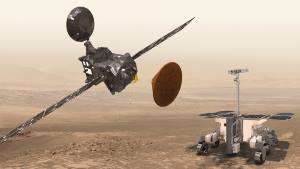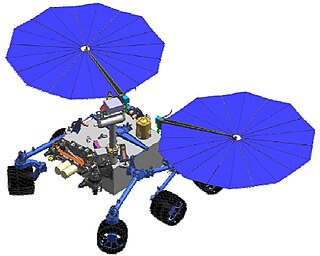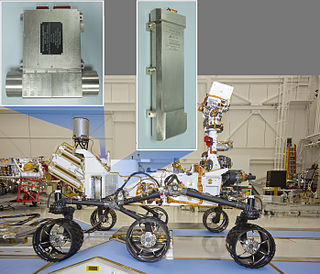Related Research Articles

The possibility of life on Mars is a subject of interest in astrobiology due to the planet's proximity and similarities to Earth. To date, no proof of past or present life has been found on Mars. Cumulative evidence suggests that during the ancient Noachian time period, the surface environment of Mars had liquid water and may have been habitable for microorganisms, but habitable conditions do not necessarily indicate life.
A biosignature is any substance – such as an element, isotope, molecule, or phenomenon that provides scientific evidence of past or present life. Measurable attributes of life include its complex physical or chemical structures, its use of free energy, and the production of biomass and wastes. A biosignature can provide evidence for living organisms outside the Earth and can be directly or indirectly detected by searching for their unique byproducts.

ExoMars is an astrobiology programme of the European Space Agency (ESA) and the Russian space agency (Roscosmos).

The Astrobiology Field Laboratory (AFL) was a proposed NASA rover that would have conducted a search for life on Mars. This proposed mission, which was not funded, would have landed a rover on Mars in 2016 and explore a site for habitat. Examples of such sites are an active or extinct hydrothermal deposit, a dry lake or a specific polar site.

Mawrth Vallis is a valley on Mars, located in the Oxia Palus quadrangle at 22.3°N, 343.5°E with an elevation approximately two kilometers below datum. Situated between the southern highlands and northern lowlands, the valley is a channel formed by massive flooding which occurred in Mars’ ancient past. It is an ancient water outflow channel with light-colored clay-rich rocks.

The Mars Astrobiology Explorer-Cacher (MAX-C), also known as Mars 2018 mission, was a NASA concept for a Mars rover mission, proposed to be launched in 2018 together with the European ExoMars rover. The MAX-C rover concept was cancelled in April 2011 due to budget cuts.
Rosalind Franklin, previously known as the ExoMars rover, is a planned robotic Mars rover, part of the international ExoMars programme led by the European Space Agency and the Russian Roscosmos State Corporation. The mission was scheduled to launch in July 2020, but was postponed to 2022. The Russian invasion of Ukraine has caused an indefinite delay of the programme, as the member states of the ESA voted to suspend the joint mission with Russia; in July 2022, ESA terminated its cooperation on the project with Russia. As of May 2022, the launch of the rover is not expected to occur before 2028 due to the need for a new non-Russian landing platform.

The Dynamic Albedo of Neutrons (DAN) instrument is an experiment mounted on the Mars Science Laboratory'sCuriosity rover. It is a pulsed sealed-tube neutron source and detector used to measure hydrogen or ice and water at or near the Martian surface. The instrument consists of the detector element (DE) and a 14.1 MeV pulsing neutron generator (PNG). The die-away time of neutrons is measured by the DE after each neutron pulse from the PNG. DAN was provided by the Russian Federal Space Agency, funded by Russia and is under the leadership of Principal Investigator Igor Mitrofanov.
The PanCam assembly is a set of two wide angle cameras for multi-spectral stereoscopic panoramic imaging, and a high resolution camera for colour imaging that has been designed to search for textural information or shapes that can be related to the presence of microorganisms on Mars. This camera assembly is part of the science payload on board the European Space Agency'sRosalind Franklin rover, tasked to search for biosignatures and biomarkers on Mars. The rover is planned to be launched in August–October 2022 and land on Mars in spring 2023.

Icebreaker Life is a Mars lander mission concept proposed to NASA's Discovery Program. The mission involves a stationary lander that would be a near copy of the successful 2008 Phoenix and InSight spacecraft, but would carry an astrobiology scientific payload, including a drill to sample ice-cemented ground in the northern plains to conduct a search for biosignatures of current or past life on Mars.
ExoLance is a low-cost mission concept that could hitch a ride on other missions to Mars in an effort to look for evidence of subsurface life.
The Mars Organic Molecule Analyser (MOMA) is a mass spectrometer-based instrument on board the Rosalind Franklin rover to be launched in 2028 to Mars on an astrobiology mission. It will search for organic compounds in the collected soil samples. By characterizing the molecular structures of detected organics, MOMA can provide insights into potential molecular biosignatures. MOMA will be able to detect organic molecules at concentrations as low as 10 parts-per-billion by weight (ppbw). MOMA examines solid crushed samples exclusively; it does not perform atmospheric analyses.
Mars Multispectral Imager for Subsurface Studies (Ma_MISS) is a miniaturized imaging spectrometer designed to provide imaging and spectra by reflectance in the near-infrared (NIR) wavelength region and determine the mineral composition and stratigraphy. The instrument is part of the science payload on board the European Rosalind Franklin rover, tasked to search for biosignatures, and scheduled to launch not earlier than 2028. Ma_MISS is essentially inside a drill on the Rover, and will take measurements of the sub-surface directly.

MicrOmega-IR is an infrared hyperspectral microscope that is part of the science payload on board the European Rosalind Franklin rover, tasked to search for biosignatures on Mars. The rover is planned to be launched not earlier than 2028. MicrOmega-IR will analyse in situ the powder material derived from crushed samples collected by the rover's core drill.
Raman Laser Spectrometer (RLS) is a miniature Raman spectrometer that is part of the science payload on board the European Space Agency'sRosalind Franklin rover, tasked to search for biosignatures and biomarkers on Mars. The rover is planned to be launched not earlier than 2028 and land on Mars in 2029.
Infrared Spectrometer for ExoMars (ISEM) is an infrared spectrometer for remote sensing that is part of the science payload on board the European Space Agency'sRosalind Franklin rover, tasked to search for biosignatures and biomarkers on Mars. The rover is planned to be launched not earlier than 2028 and land on Mars in 2029.
WISDOM is a ground-penetrating radar that is part of the science payload on board the European Space Agency'sRosalind Franklin rover, tasked to search for biosignatures and biomarkers on Mars. The rover is planned to be launched not earlier than 2028 and land on Mars in 2029.
The Fine-Resolution Epithermal Neutron Detector (FREND) is a neutron detector that is part of the instrument payload on board the Trace Gas Orbiter (TGO), launched to Mars in March 2016. This instrument is currently mapping hydrogen levels to a maximum depth of 1 m beneath the Martian surface, thus revealing shallow water ice distribution. This instrument has an improved resolution of 7.5 times over the one Russia contributed to NASA's 2001 Mars Odyssey orbiter.
CLUPI is a miniaturized camera system on board the planned European Space Agency Rosalind Franklin rover. CLUPI was designed to acquire high-resolution close-up images in colour of soils, outcrops, rocks, drill fines and drill core samples, as well as and the search for potential biosignature structures and patterns. This camera assembly is part of the science payload on board the European Space Agency'sRosalind Franklin rover, tasked to search for biosignatures and biomarkers on Mars. The rover is planned to be launched not earlier than 2028 and land on Mars in 2029.
Signs Of LIfe Detector (SOLID) is an analytical instrument under development to detect extraterrestrial life in the form of organic biosignatures obtained from a core drill during planetary exploration.
References
- ↑ Vago, Jorge L.; et al. (July 2017). "Habitability on Early Mars and the Search for Biosignatures with the ExoMars Rover". Astrobiology . 17 (6–7): 471–510. Bibcode:2017AsBio..17..471V. doi:10.1089/ast.2016.1533. PMC 5685153 . PMID 31067287.
- 1 2 "ExoMars 2018 mission". Институт Космических Исследований Space Research Institute. Retrieved 15 March 2016.
- ↑ "The ExoMars Project". RussianSpaceWeb.com. Retrieved 22 October 2013.
- ↑ Mitrofanov, I. G.; et al. (July 2017). "The ADRON-RM Instrument Onboard the ExoMars Rover". Astrobiology . 17 (6–7): 585–594. Bibcode:2017AsBio..17..585M. doi:10.1089/ast.2016.1566. PMID 28731818.
- ↑ Howell, Elizabeth (July 24, 2018). "ExoMars: Searching for Life on Mars". Space.com . Retrieved March 13, 2020.
- 1 2 3 4 5 6 7 The ADRON-RM Instrument Onboard the ExoMars Rover. I.G. Mitrofanov, M.L. Litvak, Y. Nikiforov, I. Jun, Y.I. Bobrovnitsky, D.V. Golovin, A.S. Grebennikov, F.S. Fedosov, A.S. Kozyrev, D.I. Lisov, A.V. Malakhov, M.I. Mokrousov, A.B. Sanin, V.N. Shvetsov, G.N. Timoshenko, T.M. Tomilina, V.I. Tret'yakov, and A.A. Vostrukhin. Astrobiology , Vol. 17, No. 6-7. 1 July 2017. doi : 10.1089/ast.2016.1566
- ↑ "Mars Science Laboratory: Mission". NASA/JPL. Retrieved August 6, 2012.
- ↑ Webster, Guy (April 8, 2013). "Remaining Martian Atmosphere Still Dynamic". NASA. Archived from the original on February 13, 2017. Retrieved April 9, 2013.
